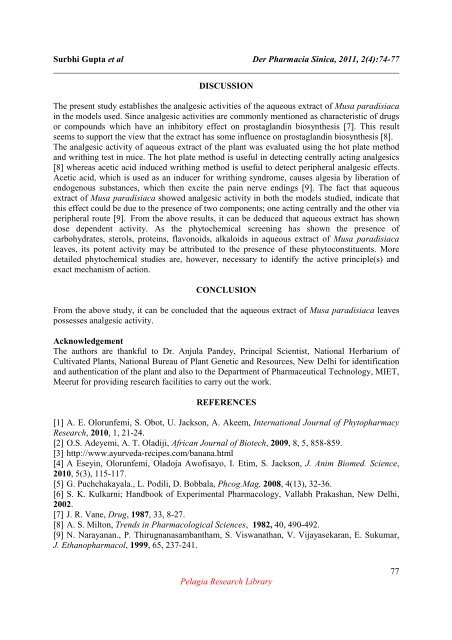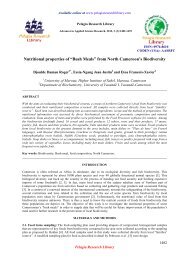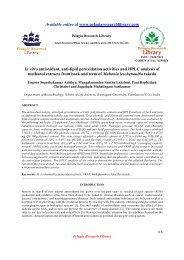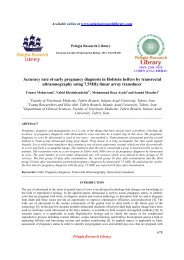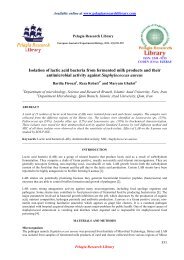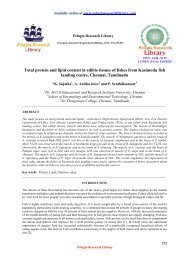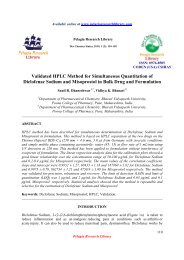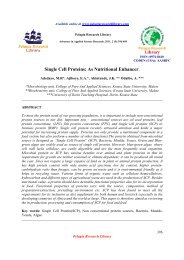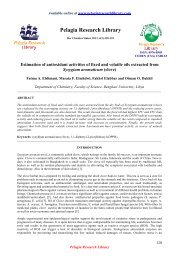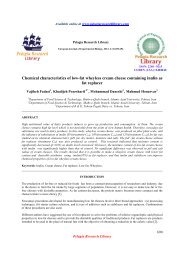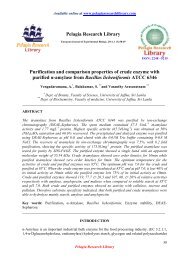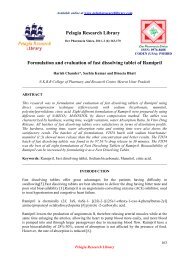Analgesic activity of aqueous extract of Musa paradisiaca - Pelagia ...
Analgesic activity of aqueous extract of Musa paradisiaca - Pelagia ...
Analgesic activity of aqueous extract of Musa paradisiaca - Pelagia ...
Create successful ePaper yourself
Turn your PDF publications into a flip-book with our unique Google optimized e-Paper software.
Surbhi Gupta et al Der Pharmacia Sinica, 2011, 2(4):74-77<br />
______________________________________________________________________________<br />
DISCUSSION<br />
The present study establishes the analgesic activities <strong>of</strong> the <strong>aqueous</strong> <strong>extract</strong> <strong>of</strong> <strong>Musa</strong> <strong>paradisiaca</strong><br />
in the models used. Since analgesic activities are commonly mentioned as characteristic <strong>of</strong> drugs<br />
or compounds which have an inhibitory effect on prostaglandin biosynthesis [7]. This result<br />
seems to support the view that the <strong>extract</strong> has some influence on prostaglandin biosynthesis [8].<br />
The analgesic <strong>activity</strong> <strong>of</strong> <strong>aqueous</strong> <strong>extract</strong> <strong>of</strong> the plant was evaluated using the hot plate method<br />
and writhing test in mice. The hot plate method is useful in detecting centrally acting analgesics<br />
[8] whereas acetic acid induced writhing method is useful to detect peripheral analgesic effects.<br />
Acetic acid, which is used as an inducer for writhing syndrome, causes algesia by liberation <strong>of</strong><br />
endogenous substances, which then excite the pain nerve endings [9]. The fact that <strong>aqueous</strong><br />
<strong>extract</strong> <strong>of</strong> <strong>Musa</strong> <strong>paradisiaca</strong> showed analgesic <strong>activity</strong> in both the models studied, indicate that<br />
this effect could be due to the presence <strong>of</strong> two components; one acting centrally and the other via<br />
peripheral route [9]. From the above results, it can be deduced that <strong>aqueous</strong> <strong>extract</strong> has shown<br />
dose dependent <strong>activity</strong>. As the phytochemical screening has shown the presence <strong>of</strong><br />
carbohydrates, sterols, proteins, flavonoids, alkaloids in <strong>aqueous</strong> <strong>extract</strong> <strong>of</strong> <strong>Musa</strong> <strong>paradisiaca</strong><br />
leaves, its potent <strong>activity</strong> may be attributed to the presence <strong>of</strong> these phytoconstituents. More<br />
detailed phytochemical studies are, however, necessary to identify the active principle(s) and<br />
exact mechanism <strong>of</strong> action.<br />
CONCLUSION<br />
From the above study, it can be concluded that the <strong>aqueous</strong> <strong>extract</strong> <strong>of</strong> <strong>Musa</strong> <strong>paradisiaca</strong> leaves<br />
possesses analgesic <strong>activity</strong>.<br />
Acknowledgement<br />
The authors are thankful to Dr. Anjula Pandey, Principal Scientist, National Herbarium <strong>of</strong><br />
Cultivated Plants, National Bureau <strong>of</strong> Plant Genetic and Resources, New Delhi for identification<br />
and authentication <strong>of</strong> the plant and also to the Department <strong>of</strong> Pharmaceutical Technology, MIET,<br />
Meerut for providing research facilities to carry out the work.<br />
REFERENCES<br />
[1] A. E. Olorunfemi, S. Obot, U. Jackson, A. Akeem, International Journal <strong>of</strong> Phytopharmacy<br />
Research, 2010, 1, 21-24.<br />
[2] O.S. Adeyemi, A. T. Oladiji, African Journal <strong>of</strong> Biotech, 2009, 8, 5, 858-859.<br />
[3] http://www.ayurveda-recipes.com/banana.html<br />
[4] A Eseyin, Olorunfemi, Oladoja Aw<strong>of</strong>isayo, I. Etim, S. Jackson, J. Anim Biomed. Science,<br />
2010, 5(3), 115-117.<br />
[5] G. Puchchakayala., L. Podili, D. Bobbala, Phcog.Mag, 2008, 4(13), 32-36.<br />
[6] S. K. Kulkarni; Handbook <strong>of</strong> Experimental Pharmacology, Vallabh Prakashan, New Delhi,<br />
2002.<br />
[7] J. R. Vane, Drug, 1987, 33, 8-27.<br />
[8] A. S. Milton, Trends in Pharmacological Sciences, 1982, 40, 490-492.<br />
[9] N. Narayanan., P. Thirugnanasambantham, S. Viswanathan, V. Vijayasekaran, E. Sukumar,<br />
J. Ethanopharmacol, 1999, 65, 237-241.<br />
<strong>Pelagia</strong> Research Library<br />
77


